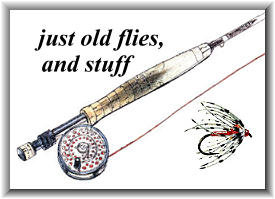"It was after Albert Everett Hendrickson, of Scarsdale, New York, that this fly was named.
Of this pattern Roy Steenrod, State Conservation Inspector, whose home is in Liberty, New York, says:
"Theodore Gordon tied flies for A.E. Hendrickson. After Gordon's death in 1915,
A.E. as it was that I always called him, wrote to me about the tying of flies for him
and in May, 1915, he came to Liberty to see me. He was accompanied by George
Stephenson and from that time until the passing of A.E. we fished together each year.
Our fishing trips took place on the Esopus, Neversink, Willowemoc and Beaverkill
Rivers. It was about this time that the dry fly became popular in the U.S. and on
the above rivers.

"One day in 1916, while we were fishing the Beaverkill below the junction pool at Roscoe,
a hatch of flies came on. We had never seen the fish rise so freely for any fly as they did
for this hatch. I caught one of the flies and put it into my fly box, and after lunch that day
at Ferdon's I tied some patterns of the fly as nearly as I could. We took fish with fly day
in and day out, and for years it proved to be a killer and is so today. One day, while sitting
on the bank of the stream perhaps two years after I had tied the first patterns, the matter
was brought up as to which I would call or name the fly. Looking at A.E., the best friend
a person could ever wish to have, I said, 'the fly is the Hendrickson.' I saw at once that
A.E. was pleased.
"Since the first Hendrickson, several patterns have been put on the market, called the light
and dark Hendrickson, but none are tied true to color. The Hendrickson is tied with the
tails from the crest of a golden pheasant; the wings - wood duck; body - fawn colored
fur from the belly of a red fox; hackle - dun, almost transparent, or water color."
The first single-handed, detachable butt, dryfly salmon rod was made to Mr.
Hendricksons's order and specifications by Jim Payne, son of Ed. Payne, original
founder of the Payne Rod Company and former employee of Hiram L. Leonard.
Hendrickson was the first to conceive the idea of and actually catch baby tarpon
on flies, which he did in Panama." "
Credits: From Fly Patterns and Their Origins by Harold Hinsdill Smedley,
published by Westshore Publications, Muskegon, Michigan 1950. Ours sincere thanks to Rich Colo.
~ LadyFisher
|

